Stars
1/73
There's no tags or description
Looks like no tags are added yet.
Name | Mastery | Learn | Test | Matching | Spaced |
|---|
No study sessions yet.
74 Terms
Why are most land telescopes in optical or radio?
The atmosphere blocks all other wavelengths
Bolometric
measured across all wavelengths
Bandpass
range of wavelength
Distance modulus equation

Planck’s law for BB radiation
When graphed, total energy = area under curve

How many steradians in a sphere?
4π
Rate of detections at a detector from a point source propagating as a sphere

Luminosity of a star

Effective temperature of the sun
5781K
In real stellar spectra, what causes continuum, emission and absorption lines?
continuum produced by thermal emission from dense gas
emission lines produced by the decay to lower states of electrons that moved to higher states in hot gas by temperature and collisions
absorption lines produced from a electrons in a cooler gas absorbing and re-emitting photons from the star
H transition lines
Lyman (to ground state)
Balmer (to n=2)
Paschen (to n=3)
The spectral classes of stars
-O-B-A-F-G-K-M
-based on temperature (O hottest, M coolest)
-subdivisions e.g. G0-G9 (0 hot end, 9 cool end)
Why do H lines fade for hot stars but He are still seen?
-H ionised so no absorption lines
-He has very tightly bound electrons, so high T required to raise them from ground state. Allows absorption at visible wavelengths.
What stars are molecular lines seen in?
Cooler stars
What stars are metal lines seen in?
Sun-like stars
How does the luminosity classification of stars work?
-higher gravity changes width
-changes luminosity
-gives information of radius
Factors controlling line strength
Excitation
Ionisation
Quantum numbers defining quantum states
n = energy
l = ang. mom.
ml = alignment
ms = spin
Boltzmann Equation
gA = number of states with energy EA

Ratio of number of electrons in energy state m to total number of electrons in all states
U(T) partition function

Saha equation
Ni = number of particles in ionisation state 1

Ratio of intensity at distance z to intensity at z = 0

Mean free path for a photon to travel

Optical depth
Often interpreted as how far we can see into a material
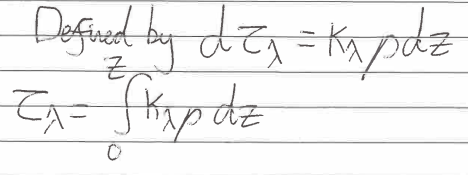
Sources of opacity
bound-bound transitions
bound free absorption
free-free absorption
scattering
Bound-free absorption
ionisation
each state has a smooth linear spectrum with a cut off
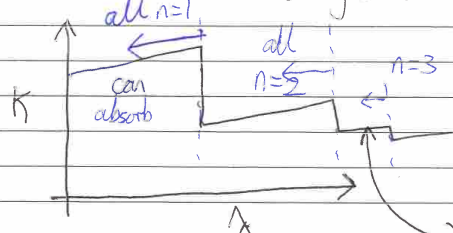
Free-Free absorption
free electron absorbing photon
follows Kramer’s Law

Scattering
Rayleigh scattering with atoms and low energy photons. Elastic
Compton scattering on electrons. Inelastic
Thomson scattering on electrons. Elastic. Low energy limit of Compton
Line broadening
lines in spectra should ideally be infinitely thin
instead they have thickness
Line broadening by natural broadening
from uncertainty principle
electron in excited state for finite time so can only have uncertain value

Line broadening by Doppler broadening
from motion of absorbing atom

Line Broadening by pressure broadening
uncertainty principle again
collisions shorten electron lifetime in state

Line broadening by stellar rotation
constant doppler shift from rotating star

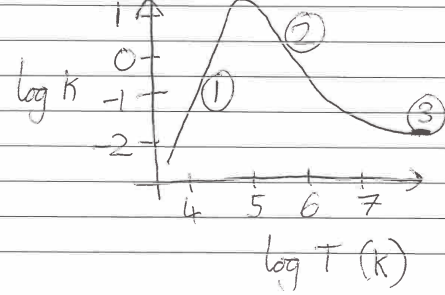
Combined opacity spectrum sections
1) H- opacity, steep rise as number of free electrons rises with T
2) Follows Kramer’s Law, driven by b-f and f-f absorption
3) all electrons free, converges to Thomson scattering coefficient
Radiative transfer equation
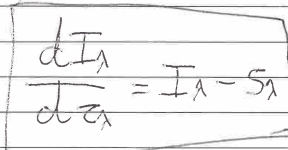
Local thermal equilibrium
T constant in region
velocity distribution follows Maxwell-Boltzmann
photon mean free path small
Optically thick, T non zero so LTE is BB
How does local thermal equilibrium explain emission and absorption lines?
emission: hot gas, not dense enough for pure BB
absorption: dense BB emitter with cold gas in front

Radiation pressure equation

Temperature profile of star
‘surface’ we see is at optical density of 2/3

Limb darkening
at star’s edges, we see cooler T
redder wavelength
less intensity
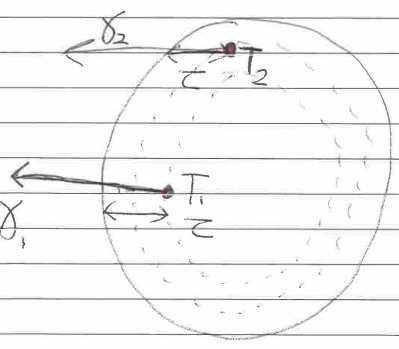
Hydrostatic equilibrium equation

Mass conservation equation

Energy generation conservation equation
ε = energy generation rate per unit mass

Energy transport through radiation equation

Schwarzschild criterion for stability

Virial Theorem

Timescale =
quantity / rate of change
Gravitational timescale
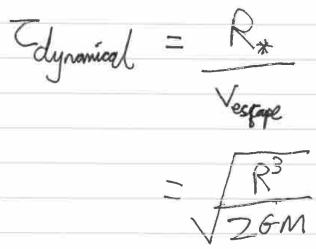
Thermal timescale

Nuclear timescale
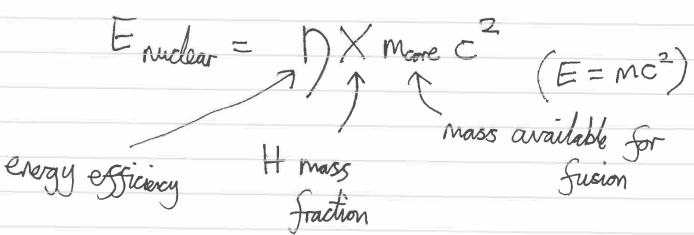
PP1 chain for Hydrogen fusion
1H —> 2H + e+ + ve
2H + 1H —> 3He + γ
2 3He —> 4He + 2 1H
Deuterium formed from beta decay of 1p to 1n
Issue with the fusion process and how it is overcome
thermal energy must be enough to overcome coulomb force for fusion
required temperature is higher than actual temperature of the sun
overcome by quantum tunnelling
What do stars form from?
Gravitational collapse of clouds of material
Virial theorem:
2U > |Ω| cloud expands
2U < |Ω| cloud collapses
Gravitational potential of cloud

Jeans mass required for cloud collapse

Initial mass function of stars details
all stars born from the same cloud have same mass distribution proportional to Ma
If exponent < 0, more low mass stars due to cloud fragment
massive stars have higher L so produce more of the observed light
Protostars details
cloud collapses to pre-main sequence star after ~ 106 yr
must conserve angular momentum through accretion disk, jets and rotation
Deuterium burning after collapse forms protostar ~107 yr after collapse
Main sequence details
H fusion through PP chains
He builds up in core
supported by radiation pressure
~ 7 Gyr for Sun
Star clusters
stars formed from the same cloud
same age
similar composition
same distance
very useful in observing stellar evolution
Blue stragglers
stars that break HR model
binaries
results of stellar mergers
Subgiant branch
core exhausted H
H burning shell feeds core He
grows until thermal pressure can’t support it
eventually, core contracts and becomes degenerate
Red Giant branch
core contracts from increased mass
envelope expands
luminosity increases with core and shell temp
radius increases
effective temp decreases
Helium flash
end of RGB, core is degenerate
no regulation so runaway fusion
He fusion ignites core in a few seconds
energy released comparable to a galaxy, mostly absorbed by outer layers
ends when degeneracy lifted
Horizontal branch
core He burning to C + O
H burning shell
Temp of Horizontal branch about 10% of main sequence temp
Asymptotic giant branch (AGB)
He burning in shell leads to H shell expansion, cooling H shell so less H fusion
He depletes, H shell reignites, deposits He on shell below and reignites He fusion
Giant convective envelope formed, ejected by superwinds
leaves a degenerate C+O core for M >~ 8 M☉
Post AGB
planetary nebula from ejected material
exposed hot C + O core
white dwarf
Post AGB for higher mass stars
similar but faster than low mass stars until AGB
no He flash
Fusion continues C - O - Si - Fe
Fe stable, shell forms
core collapse if above Chandrasekhar limit
supernova
Steps to a supernova
gravitational collapse, free fall timescale
inner core collapse
strong nuclear force causes bounce back
1% energy released as kinetic, rest as neutrinos
Remnants of a supernova
for stars M <~ 25M☉, neutron star
much more massive stars leave black hole
Scaling law for low mass stars
μ = average mass per particle in the core

Binary stars
formed from large molecular clouds
50% of sun like stars are in binaries
rises to 100% for O type
Visual binaries
see both components
can track orbits

Spectroscopic binaries
evidence of binary in spectra
e.g. two sets of absorption lines, Doppler shift of lines

Eclipsing binaries
one star can block light from other
measure radii from light curve
with spectroscopy, we get R and M